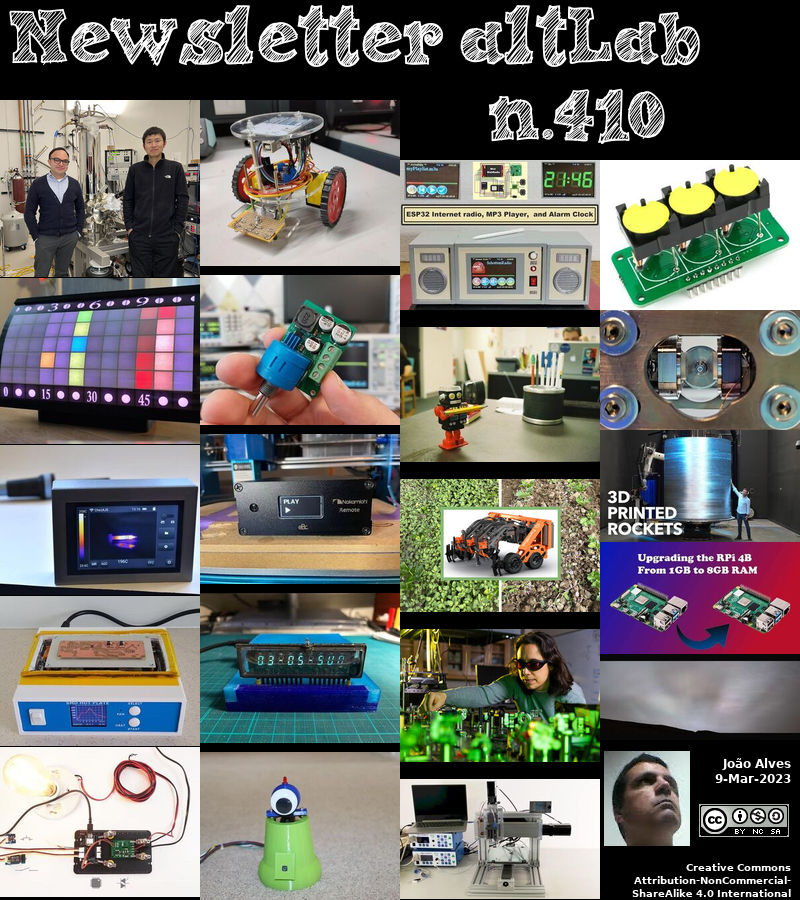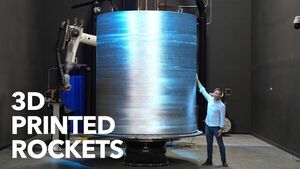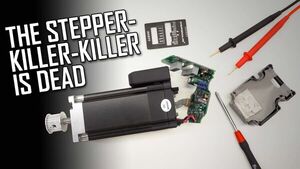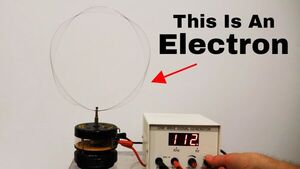2023-03-09 - Nº 410
Editorial
Esta é a Newsletter Nº 410 que se apresenta com o mesmo formato que as anteriores. Se gostar da Newsletter partilhe-a!
Todas as Newsletters encontram-se indexadas no link.
Esta Newsletter tem os seguintes tópicos:
Faz hoje anos que nascia, em 1856, o inventor americano Edward Goodrich Acheson. Ele descobriu o carborundum abrasivo, a segunda substância mais dura (ao lado de diamantes) e mais tarde aperfeiçoou um método de fabrico de grafite. No início da sua carreira, tinha trabalhado no Menlo Park de Thomas Edison (1880-84), mas partiu para se tornar um inventor independente. Em 1891, estava a experimentar uma fornalha eléctrica, tentando fazer diamantes a partir de uma mistura fundida de coque em pó e argila. Em vez de diamantes, descobriu que tinha feito cristais pequenos, granulosos e duros quase tão duros como os diamantes. Ele determinou que esta substância cristalina era carboneto de silício. Era muito eficaz como abrasivo, que Acheson patenteou (28 de Fevereiro de 1892) e chamou "carborundum". Ele criou a Companhia Carborundum (1894), para fazer mós, pedras de amolar, e abrasivos em pó.
Faz também hoje anos que nascia, em 1923, o físico austro-americano Walter Kohn. Ele partilhou (com John A. Pople) o Prémio Nobel da Química de 1998. O prémio reconheceu o seu trabalho individual sobre cálculos em química quântica. A parte de Kohn no prémio foi para o desenvolvimento da sua teoria da densidade-funcional. Isto aplicou a matemática complexa para fornecer uma técnica de modelação que incorporou a mecânica quântica no estudo das propriedades electrónicas dos materiais. A teoria de Kohn revolucionou de tal forma a ciência dos materiais, que foi referida em cerca de metade de todas as publicações de química quântica que se seguiram. Ele fez grandes contribuições para a física dos semicondutores, supercondutividade, física de superfícies e catálise.
Por fim, faz hoje anos que nascia, em 1934, o cosmonauta soviético Yuri Gagarin. Ele, a 12 de Abril de 1961, tornou-se o primeiro homem a viajar para o espaço aos 27 anos de idade. Formou-se na escola de cadete da Força Aérea Soviética em 1957. Voluntariou-se para se tornar cosmonauta e juntou-se a um grupo de pilotos de teste para treino. Três dias antes do lançamento, foi informado de que tinha sido seleccionado para pilotar a nave espacial Vostok 1. Orbitou a Terra uma vez em 1 hora e 29 minutos a uma altitude máxima de 301 km. Nunca mais foi para o espaço, mas treinou outros cosmonautas e percorreu várias outras nações. Gagarin foi morto com outro piloto na queda de um avião a jacto de dois lugares enquanto estava no que foi descrito como um voo de treino de rotina.
Em 1948, a Universidade da Califórnia em Berkeley e a Comissão de Energia Atómica anunciaram oficialmente a produção artificial de mésons utilizando o ciclotrão de 184 polegadas no Laboratório de Radiação da universidade. Os mésons na natureza tinham sido anteriormente vistos por Carl Anderson como pistas de câmara de nuvens, e outros (formados por raios cósmicos) tinham sido detectados por outros cientistas em placas fotográficas feitas a grande altitude. Agora, nos limites da energia disponível do ciclotrão, estas partículas de curta duração foram geradas artificialmente por Eugene Gardner e C.M.G. Lattes, utilizando um feixe de partículas alfa aceleradas disparadas sobre um alvo de carbono fino. O tempo relatou a descoberta e deu a entender que o estudo dos mésons poderia "conduzir na direcção de uma fonte de energia atómica muito melhor do que a fissão de urânio".
Na Newsletter desta semana apresentamos diversas noticias, artigos científicos, projetos de maker e alguns vídeos interessantes.
 João Alves ([email protected])
João Alves ([email protected])
O conteúdo da Newsletter encontra-se sob a licença  Creative Commons Attribution-NonCommercial-ShareAlike 4.0 International License.
Creative Commons Attribution-NonCommercial-ShareAlike 4.0 International License.
Novidades da Semana
Outras Notícias
Sony Semiconductor Solutions to Release SPAD Depth Sensor for Smartphones with High-Accuracy, Low-Power Distance Measurement Performance, Powered by the Industry’s Highest*1 Photon Detection Efficiency
"Sony Semiconductor Solutions Corporation (SSS) today announced the upcoming release of the IMX611, a direct time-of-flight (dToF) SPAD depth sensor for smartphones that delivers the industry’s highest*1 photon detection efficiency. The IMX611 has a photon detection efficiency of 28%, the highest in the industry,*1 thanks to its proprietary single-photon avalanche diode (SPAD) pixel structure. *2 This reduces the power consumption of the entire system while enabling high-accuracy measurement of the distance of an object. This new sensor will generate opportunities to create new value in smartphones, including functions and applications that utilize distance information. In general, SPAD pixels are used as a type of detector in a dToF sensor, which acquire distance information by detecting the time of flight of light emitted from a source until it returns to the sensor after being reflected off an object. The IMX611 uses a proprietary SPAD pixel structure that gives the sensor the industry’s highest*1 photon detection efficiency, at 28%, which makes it possible to detect even very weak photons that have been emitted from the light source and reflected off the object." [...]

NASA’s Curiosity Views First ‘Sun Rays’ on Mars
"The veteran rover captured a dazzling sunset at the start of a new cloud-imaging campaign. Martian sunsets are uniquely moody, but NASA’s Curiosity rover captured one last month that stands out. As the Sun descended over the horizon on Feb. 2, rays of light illuminated a bank of clouds. These “sun rays” are also known as crepuscular rays, from the Latin word for “twilight.” It was the first time sun rays have been so clearly viewed on Mars. Curiosity captured the scene during the rover’s newest twilight cloud survey, which builds on its 2021 observations of noctilucent, or night-shining, clouds. While most Martian clouds hover no more than 37 miles (60 kilometers) above the ground and are composed of water ice, the clouds in the latest images appear to be at a higher altitude, where it’s especially cold." [...]

Intel’s New Agilex 7 FPGAs Deliver Industry’s Fastest Transceivers
"Today, Intel launched Intel Agilex® 7 FPGAs with F-Tile, equipped with the fastest field-programmable gate array (FPGA) transceivers available on the market1 and designed to help customers address challenges across the most bandwidth-intensive areas of the data-centric world, including data centers and high-speed networks. Created with embedded, networking and cloud customers in mind, Intel’s new F-Tile-enabled Agilex 7 FPGAs deliver flexible hardware solutions with industry-leading transceiver performance, delivering up to 116 gigabits per second (Gbps) and hardened 400 gigabit Ethernet (GbE) intellectual property (IP). Network operators, cloud providers and enterprise organizations need to address growing bandwidth requirements and are looking for cost-effective, flexible hardware solutions. Agilex 7 with F-Tile directly meets these needs and enables networking, cloud or embedded applications, bandwidth-intensive applications like IPUs (infrastructure processing units) and compute-intensive applications. Additionally, it doubles the bandwidth per channel compared to previous-generation Intel FPGAs and enables new products that deliver increased data traffic while reducing power and maintaining strict form-factor limitations. Built on Intel’s 10 nanometer SuperFin process technology, Agilex 7 with F-Tile offers customers the flexibility to create a custom chip design suited to their specific needs." [...]

Single Pair Ethernet (SPE) 10BASE-T1S and 100BASE-T1 Devices Transform IIoT at the Edge and in Higher-Speed Applications
"Microchip’s SPE offering reduces cost and complexity of IIoT edge devices while supporting higher-speed Ethernet-everywhere architectures and applications SPE technology is setting the stage for all-Ethernet IIoT and industrial Operational Technology (OT) networks that are built with a new class of synchronized low-speed Ethernet edge devices and a simplified cabling infrastructure for latency-sensitive traffic streams. Microchip Technology Inc. (Nasdaq: MCHP) today announces new industrial-grade SPE products that will help fulfill SPE’s promise, from 10BASE-T1S MAC-PHYs that more easily connect edge IIoT devices to the cloud, to industrial versions of its 100BASE-T1 Time Sensitive Networking (TSN) Ethernet PHY transceivers and switches that enable higher-speed applications across far-reaching Ethernet networks. “Microchip is helping to fuel the adoption of zonal architectures in industrial applications with our new MAC-PHYs that connect to many of Microchip’s microcontrollers (MCUs) to reduce the design complexity and implementation costs for bringing a host of sensors, actuators and other products into the new 10BASE-T1S network infrastructure,” said Matthias Kaestner, vice president at Microchip. “With these new 10BASE-T1S MAC-PHYs and industrial versions of our 100BASE-T1 TSN products, we are making it easier to connect the physical world to the cloud while enabling a seamless Ethernet architecture throughout the IIoT and other industrial networks.” Microchip’s new LAN8650 and LAN8651 10BASE-T1S MAC-PHY Ethernet Controllers with Serial Peripheral Interface (SPI) simplify the implementation of zonal architectures by enabling basic MCUs, rather than higher-level MCUs with a Media Access Controller (MAC), to be used when creating sensors, actuators and other devices for the edge of OT and IT networks. These low-speed devices do not need their own communication system, and Microchip’s MAC-PHYs connect them into a standard Ethernet system all the way to the cloud over simple twisted-pair wiring. For industrial applications that require higher bandwidth, designers can use MCUs with an integrated Ethernet MAC." [...]
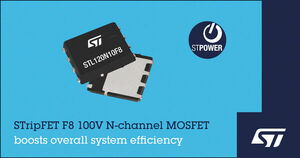
STMicroelectronics 100V industrial-grade STripFET F8 devices improve figure of merit by 40%
"STMicroelectronics’ STL120N10F8 N-channel 100V power MOSFETs combine extremely low gate-drain charge (QGD) and on-resistance RDS(on), giving 40% better figure of merit (FoM) than comparable devices of the preceding generation. The new MOSFETs leverage ST’s advanced STPOWER STripFET F8 technology, which introduces an oxide-filled trench that permits very low conduction losses combined with low gate charge for efficient switching performance. As a result, the STL120N10F8 has 4.6mΩ maximum RDS(on) (at VGS = 10V) and can operate efficiently at switching frequencies up to 600kHz. The STripFET F8 technology also ensures an output capacitance value that helps to mitigate drain-source voltage spikes and to minimize wasted charge-discharge energy. The MOSFET body-drain-diode characteristic also displays increased softness. These improvements reduce electromagnetic emissions and so ease compliance testing of the final system to demonstrate electromagnetic compatibility (EMC) according to applicable product standards." [...]
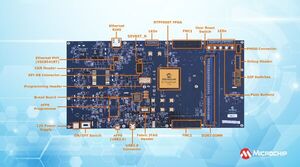
Integrated Development Kit Speeds Design of FPGA-Based Satellite Systems
"Developers can prototype with the same low-power, high-throughput Radiation-Tolerant (RT) FPGA that will be used in spaceflight Developers using FPGAs to meet satellite system payload and throughput requirements can speed designs by prototyping with space-qualified devices rather than commercial off-the-shelf silicon. Microchip Technology (Nasdaq: MCHP) today announces it has combined its flight-ready RT PolarFire® FPGA with the development kit and interfaces for evaluating design concepts based on actual in-flight electrical and mechanical characteristics. “Our new integrated development platform for space applications includes features and interfaces that are ideal for prototyping,” said Shakeel Peera, vice president of marketing for Microchip’s FPGA business unit. “Using the same package and silicon that final, in-orbit or deep-space units will have, designers can evaluate high-speed transceivers and test all of their control, DSP, communications and image-processing algorithms.” The RT PolarFire development kit supports various daughter boards and includes two fully populated high-pin count (HPC) FPGA mezzanine card connectors, DDR3 DIMM and RT Gigabit Ethernet connection, SPI flash memory, and SubMiniature Version A (SMA) connectors. Also included is radiation data and the Libero® software tool suite for programming the RT PolarFire FPGA. Microchip’s RT PolarFire FPGA increases mission-critical computing and connectivity throughput compared to SRAM FPGAs while consuming up to 50 percent less power and offering greater immunity to radiation-induced configuration Single Event Upsets (SEUs)." [...]
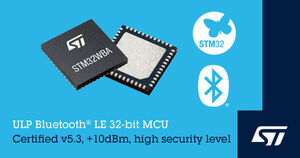
STMicroelectronics reveals STM32WBA52 wireless microcontrollers with SESIP3 security, tailored for IoT devices
"STMicroelectronics’ STM32WBA52 microcontrollers (MCUs) combine Bluetooth® LE 5.3 connectivity with ultra-low-power modes, advanced security, and a broad selection of peripherals familiar to STM32 developers. Its arrival eases the next step for IoT device developers seeking to add wireless, cut power, strengthen cyber-protection, and boost processing in the edge. The STM32WBA wireless MCU platform includes ST patented leading-edge technology. Targeted applications comprise smart home, industrial lighting, sensors, electrical switches, gateways, and portable medical devices. Leveraging ST’s investments in capacity expansion and resiliency, the STM32WBA52 is available now in the mass market and brings proven wireless capabilities from ST’s well-known ultra-low-power STM32WB MCUs. It is boosted by an Arm® Cortex®-M33 core operating at 100MHz for extra computing power, and with state-of-the-art STM32 peripherals." [...]
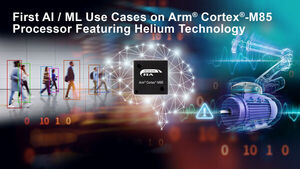
Renesas to Demonstrate First AI Implementations on the Arm Cortex-M85 Processor Featuring Helium Technology at Embedded World
"Microcontroller Leader to Showcase Superior Performance of New Processor in Demanding AI Use Cases at Embedded World 2023 Exhibition and Conference Renesas Electronics Corporation (TSE:6723), a premier supplier of advanced semiconductor solutions, today announced that it will present the first live demonstrations of artificial intelligence (AI) and machine learning (ML) implementations on an MCU based on the Arm® Cortex®-M85 processor. The demos will show the performance uplift in AI/ML applications made possible by the new Cortex-M85 core and Arm’s Helium technology. They will take place in the Renesas stand - Hall 1, Stand 234 (1-234) at the embedded world 2023 Exhibition and Conference in Nuremburg Germany from March 14-16. At embedded world in 2022, Renesas became the first company to demonstrate working silicon based on the Arm Cortex-M85 processor. This year, Renesas is extending its leadership by showcasing the features of the new processor in demanding AI use cases. The first demonstration showcases a people detection application developed in collaboration with Plumerai, a leader in Vision AI, that identifies and tracks persons in the camera frame in varying lighting and environmental conditions." [...]

STMicroelectronics’ new STM32 microprocessors balance performance, power, and cost for advanced connected devices
"STM32MP13 MPUs tackle applications that challenge traditional embedded microcontrollers, combining extra performance, security-rich architecture, and energy efficiency in new cost-conscious, single-core devices. STMicroelectronics (NYSE: STM), a global semiconductor leader serving customers across the spectrum of electronics applications, is enabling the next generation of smart devices for secure, safe, and sustainable living with its latest STM32 microprocessors (MPUs). Energy savings, lower operating costs, improved safety and enhanced user experience are the main trends observed in Smart Buildings, Factory automation and smart cities. The latest applications such as industrial automation, communication gateways, payment terminals, appliances, and control panels serving these trends are demanding processors with high software-execution capability, low power consumption, strengthened security, and advanced feature integration. ST is meeting these expectations with new MPUs that build on the microcontroller (MCU) knowhow and extensive development ecosystem of its STM32 family and is now extending this product family with the new STM32MP13 MPUs, now in mass production. They are the most affordable STM32 MPUs yet and further expand the choices available to product developers." [...]
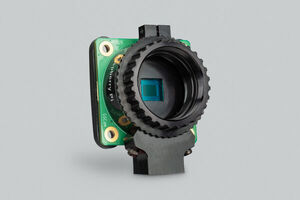
New Raspberry Pi Global Shutter Camera for machine vision and more
"Remember those new cameras we launched way back in the dawn of … January? We have another one for you — and this time we’re getting specialised. Today we’re launching something a little different: the Raspberry Pi Global Shutter Camera, available now at $50. Built around Sony’s 1.6-megapixel IMX296 sensor, the Global Shutter Camera is able to capture rapid motion without introducing rolling shutter artefacts. This makes it a great fit for sports photography, and for machine vision applications, where even small amounts of distortion can seriously degrade inference performance. Rolling shutters, global shutters Every camera we’ve released to date, from 2014’s Camera Module 1 to our High Quality Camera and beyond, has used a rolling shutter sensor." [...]
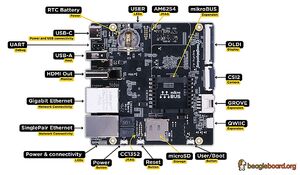
BeaglePlay® from BeagleBoard.org® brings fun to building with computers
"Connections make computing fun, collaborative, distributed, open and easy. BeaglePlay® features a wide selection of sensor and prototyping system connections with the software and the performance features to support them, making development work into play! The BeagleBoard.org® Foundation today announces the global availability of BeaglePlay®, the most adaptable open-source performance platform available. Built on our proven open source Linux approach, BeaglePlay® has a feature set that includes built-in wired and wireless connectivity and ability to connect to a wide selection of sensor and prototyping systems with thousands of options, as well as interfaces and processing performance to support them. Leveraging the Texas Instruments AM625 processor with quad 64-bit Arm® Cortex®-A53 cores, low-latency microcontroller subsystems, a dedicated Texas Instruments SimpleLink™ CC1352P7 sub-1 GHz and 2.4-GHz wireless MCU, and a Texas Instruments WiLink™ WL1807MOD Wi-Fi® module, new and experienced users can use a wide variety of application libraries and examples from Linux, Zephyr, MicroPython and numerous other open source frameworks to add an endless array of sensors, actuators, indicators and new connectivity options. BeaglePlay® software features a customized BeagleBoard.org® Debian Linux image with desktop pre-installed along with features such as Wi-Fi® access point and BeagleConnect® gateway functionality supporting quick and flexible development options." [...]
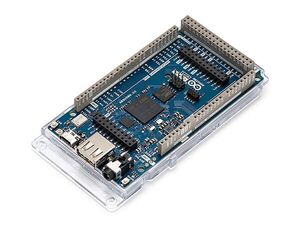
Makers, get ready to step up your game with the GIGA R1 WiFi
"A new board joins the Arduino family, and it’s the most powerful ever designed for makers, engineers and creators: today we’re announcing the GIGA R1 WiFi. Bridging you from great fun to amazing performance, it opens the door to infinite possibilities in robotics, IoT, music, computer vision, digital fabrication, and any kind of projects involving machines, interfaces, and real-time processing. Excited yet? Because we sure are. We have developed a new product for ambitious makers, offering all the power of the STM32H7 microcontroller in the same form factor as the popular Mega and Due boards – and at an accessible price point. It’s the perfect tool for artists, gamers, sound designers, researchers and more, to step up their game, level the playing field, and add power to their play." [...]
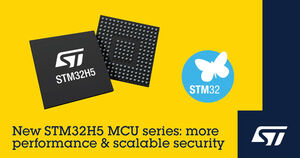
New STM32H5 MCU series from STMicroelectronics boosts performance and security for next-generation smart applications
"STMicroelectronics (NYSE: STM), a global semiconductor leader serving customers across the spectrum of electronics applications, has introduced its new performance-oriented STM32H5 microcontroller (MCU) series with cutting-edge security provided by STM32Trust TEE Security Manager for smart, connected devices. The new STM32H5 MCUs contain the embedded core from Arm®, the Cortex®-M33, which blends high performance with security, energy efficiency, and affordability, to best address the mid-range class of MCU-based applications. Indeed, it’s the world’s highest performing Cortex-M33 implementation, running at 250MHz and 375 DMIPS for an EEMBC CoreMark® industry-reference score of 1023. The STM32H5 series is designed to accelerate innovation at scale for the coming generations of smart, connected devices, which provide more intelligence “in the edge” and also strengthens defenses against attacks on IoT assets. The Cortex-M33 core brings Arm’s TrustZone® architecture. Building on this, ST adds a range of its own security features, including some developed with ST Authorized Partner, ProvenRun." [...]

STMicroelectronics’ all-in-one motion and bone-conduction sensor saves space and power in hearables and headsets
"STMicroelectronics’ LSM6DSV16BX is a unique highly integrated sensor that delivers tremendous space savings inside hearable devices including sports and general-purpose earbuds. It combines a 6-axis inertial measurement unit (IMU) for head tracking and activity detection with an audio accelerometer for detecting voice through bone conduction in a frequency range that exceeds 1KHz. In addition, the LSM6DSV16BX contains ST’s Qvar™ charge-variation detection technology for user-interface controls such as touching and swiping. It is ideal for applications such as true wireless stereo (TWS) headphones and augmented-, virtual-, and mixed-reality (AR/VR/MR) headsets. While delivering unprecedented integration, the LSM6DSV16BX brings superior features to the ear. The sensor embeds ST’s Sensor Fusion Low Power (SFLP) technology, specifically designed for head tracking and 3D sound, and the in-the-edge processing resources featured in ST’s third-generation MEMS sensors." [...]

STMicroelectronics’ automotive-qualified micro-power op amp endures harsh temperature and extended mission profile
"With micro-power current consumption and 150°C operating-temperature capability, STMicroelectronics’ TSU111H 5V automotive operational amplifier delivers a combination of properties that are unusual to find in one device. Qualified to AEC-Q100 temperature Grade 0 (-40°C to 150°C), the TSU111H withstands environments that experience extreme heat such as in braking systems, combustion-engine exhaust systems, and fuel-cell generators. The high maximum temperature enables use inside sensor control units (SCUs) placed close to sensors installed in the hottest areas for optimum measurement accuracy. In less extreme environments the TSU111H, with its extended temperature range, allows a mission profile up to three times longer than an equivalent Grade-1 device qualified at 125°C. As a Grade-0 device, ST’s new op amp can operate continuously at 65°C for more than 25 years, thereby serving the entire vehicle lifetime, while Grade-1 devices are specified for eight years without failure. This is ideal for applications such as the battery-management system (BMS) of hybrid and electric vehicles, which is never turned off and must consume the least possible power." [...]
Ciência e Tecnologia
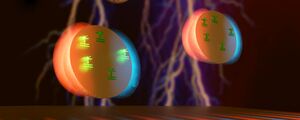
Light, electrons and energy in the mix
"Recent discoveries show previously unknown ways to change the very nature of materials by coupling the light-induced movement of electrons to energy transitions inside them. Something very strange is formed - neither pure energy nor physical motion. "It's hard to grasp the full depth of what this means," says professor Alexandre Dmitriev. There are plenty of electrons in metals. Since the electrons move around when the electric field is applied, the metals are conductive. It's also possible to use ordinary light to make these electrons move and oscillate collectively, since part of light is an electric field that just oscillates very fast." [...]

Novel computer components inspired by brain cells
"Researchers at Empa, ETH Zurich and the "Politecnico di Milano" are developing a new type of computer component that is more powerful and easier to manufacture than its predecessors. Inspired by the human brain, it is designed to process large amounts of data fast and in an energy-efficient way. In many respects, the human brain is still superior to modern computers. Although most people can't do math as fast as a computer, we can effortlessly process complex sensory information and learn from experiences, while a computer cannot – at least not yet. And, the brain does all this by consuming less than half as much energy as a laptop. One of the reasons for the brain's energy efficiency is its structure." [...]
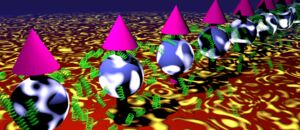
Researchers take a step towards turning interactions that normally ruin quantum information into a way of protecting it
"A new method for predicting the behavior of quantum devices provides a crucial tool for real-world applications of quantum technology Researchers have found a way to predict the behavior of many-body quantum systems coupled to their environment. The work represents a way to protect quantum information in quantum devices, which is crucial for real-world applications of quantum technology. In a study published in Physical Review Letters, researchers at Aalto University in Finland and IAS Tsinghua University in China report a new way to predict how quantum systems, such as groups of particles, behave when they are connected to the external environment. Usually, connecting a system such as a quantum computer to its environment creates decoherence and leaks, which ruin any information about what’s happening inside the system. Now, the researchers developed a technique which turns that problem into its a solution. The research was carried out by Aalto doctoral researcher Guangze Chen under the supervision of Professor Jose Lado and in collaboration with Fei Song from IAS Tsinghua." [...]
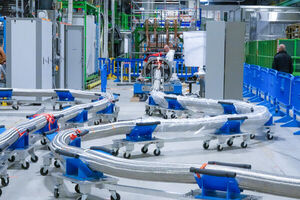
Superconductivity for sustainability: a new superconducting link for the High-Luminosity LHC
"A flexible cryostat and the first series of high-temperature superconducting magnesium diboride cables will form an innovative electrical transfer line to power the HL-LHC triplets The Large Hadron Collider (LHC), the world’s largest and most powerful particle accelerator, is also the largest single machine operating in the world today that uses superconductivity. The proton beams inside the LHC are bent and focused around the accelerator ring using superconducting electromagnets. These electromagnets are built from coils, made of niobium–titanium (Nb–Ti) cables, that have to operate at a temperature colder than that of outer space in order to be superconducting. This allows the current to flow without any resistance or loss of energy. The High-Luminosity LHC (HL-LHC), an upgrade of the LHC, will for the first time feature innovative electrical transfer lines known as the “Superconducting Links”. Recently, CERN’s SM18 magnet test facility witnessed the successful integration of the first series of magnesium diboride superconducting cables into a novel, flexible cryostat." [...]

Next-gen AI designers won’t crush human creativity
"If ‘design is intelligence made visible’, as author and brand consultant Alina Wheeler has framed it, then artificial intelligence (AI) and design should make a perfect match. New research shows that AI assistance can indeed create better designs, at least in simple simulated cases. The challenge for designers, and users of AI tools more generally, is clear communication of goals that initially may be nebulous. At the Finnish Center for Artificial Intelligence (FCAI), researchers are addressing this challenge by building AI that can understand human goals, without large training data sets, lengthy learning cycles or rigid optimization. Unlike, say, Amazon, which uses your shopping behavior and data from millions of customers to make targeted recommendations, tools for design, especially bespoke or highly specific projects, must take other approaches when it comes to incorporating AI. ‘In our research, a user model, based on cognitive science research of decisions, takes the place of big data,’ says Sebastiaan De Peuter, a doctoral researcher at FCAI and Aalto University’s Department of Computer Science." [...]

Lunar Telescope Will Search for Ancient Radio Waves
"DOE and NASA are collaborating to land a radio telescope on the far side of the moon and probe an unexplored era of the early universe. Scientists at the U.S. Department of Energy’s (DOE) Brookhaven National Laboratory are leading a new effort to land a radio telescope on the moon. If successful, the project will mark the first step towards exploring the Dark Ages of the universe. The Dark Ages are an early era of cosmological history starting about 380,000 years after the Big Bang. There were no stars or planets in the Dark Ages. It’s a point in time that scientists have never been able to observe." [...]

Electric Vehicle Batteries Could Get Big Boost With New Polymer Coating
"Scientists at Lawrence Berkeley National Laboratory (Berkeley Lab) have developed a conductive polymer coating – called HOS-PFM – that could enable longer lasting, more powerful lithium-ion batteries for electric vehicles. “The advance opens up a new approach to developing EV batteries that are more affordable and easy to manufacture,” said Gao Liu, a senior scientist in Berkeley Lab’s Energy Technologies Area who led the development of the material. The HOS-PFM coating conducts both electrons and ions at the same time. This ensures battery stability and high charge/discharge rates while enhancing battery life. The coating also shows promise as a battery adhesive that could extend the lifetime of a lithium-ion battery from an average of 10 years to about 15 years, Liu added. To demonstrate HOS-PFM’s superior conductive and adhesive properties, Liu and his team coated aluminum and silicon electrodes with HOS-PFM, and tested their performance in a lithium-ion battery setup." [...]

Titanic robots make farming more sustainable
"MIT alumnus-founded FarmWise uses autonomous machines to snip weeds while preserving crops, eliminating the need for herbicides. There’s a lot riding on farmers’ ability to fight weeds, which can strangle crops and destroy yields. To protect crops, farmers have two options: They can spray herbicides that pollute the environment and harm human health, or they can hire more workers. Unfortunately, both choices are becoming less tenable. Herbicide resistance is a growing problem in crops around the world, while widespread labor shortages have hit the agricultural sector particularly hard. Now the startup FarmWise, co-founded by Sebastien Boyer SM ’16, is giving farmers a third option." [...]
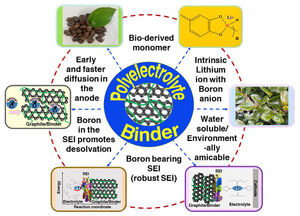
Speeding Up Extreme Fast Charging Capability in Lithium-Ion Batteries
"Researchers show that inherent lithium ions in bioderived borate polymer enhance 'extreme fast charging' capability in graphite anodes Lithium-ion batteries dominate among energy storage devices and are the battery of choice for the electric vehicle industry. Improving battery performance is a constant impetus to current research in this field. Towards this end, a group of researchers from Japan Advanced Institute of Science and Technology synthesized a lithium borate-type aqueous polyelectrolyte binder for graphite anodes. Their new binder helped improve Li-ion diffusion and lower impedance compared to conventional batteries. Current society is transitioning en masse from fossil fuels to renewable resources and electric batteries. Despite the urgency to switch to greener methods, core challenges related to efficiency and sustainability pose a hurdle to overcome." [...]

Robot armies duke it out in Battlecode’s epic on-screen battles
"The long-running programming competition encourages skills and friendships that last a lifetime. In a packed room in MIT’s Stata Center, hundreds of digital robots collide across a giant screen projected at the front of the room. A crowd of students in the audience gasps and cheers as the battle’s outcome hangs in the balance. In an upper corner of the screen, the people who have programmed the robot armies’ strategies narrate the action in real time. This isn’t the latest e-sports event, it’s MIT’s long-running Battlecode competition. Open to student teams around the world, Battlecode tasks participants with writing the code to program entire armies — not just individual bots — before they duke it out." [...]

USTC Realizes Highly Bright and Stable Single-crystal Perovskite LEDs
"A research team led by Prof. XIAO Zhengguo from the University of Science and Technology of China (USTC) has grown high-quality, large-area, ultra-thin perovskite single crystals (SCs) using space-confined inverse-temperature crystallization (SIC) method, creating a new type of highly bright and stable single-crystal perovskite LED (SC-PeLED). The work was published in Nature Photonics on February 27th. Metal-halide perovskites have become a new generation of LED display and lighting material because of their narrow emission bandwidth, tunable emission wavelength, and bipolar conduction. However, the operational stability of most reported PeLED devices still lags behind those of the organic LEDs (OLEDs) and quantum-dot LEDs (QLEDs). The stability of PeLED devices is affected by various factors such as ion migration, carrier injection imbalance, and Joule heating. To tackle the above issues, XIAO’s research team used the SIC method to directly grow in situ perovskite SCs with a composition of methylammonium-formamidinium lead bromide (MA0.8FA0.2PbBr3) on top of a hole-transport layer (HTL)." [...]
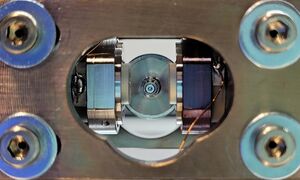
Two-dimensional quantum freeze
"Researchers at ETH Zurich and TII Abu Dhabi, with the support of quantum optics theorists from Innsbruck, Austria, have succeeded in simultaneously cooling the motion of a tiny glass sphere in two dimensions to the quantum ground-state. This represents a crucial step towards a 3D ground-state cooling of a massive object and opens up new opportunities for the design of ultra-sensitive sensors. Glass nanoparticles trapped by lasers in extreme vacuum are considered a promising platform for exploring the limits of the quantum world. Since the advent of quantum theory, the question at which sizes an object starts being described by the laws of quantum physics rather than the rules of classical physics has remained unanswered. A team formed by Lukas Novotny (Zurich), Markus Aspelmeyer (Vienna), Oriol Romero-Isart (Innsbruck), and Romain Quidant (Zurich) is attempting to answer precisely this question within the ERC-Synergy project Q-Xtreme. A crucial step on the way to this goal is to reduce the energy stored in the motion of the nanoparticle as much as possible, i.e." [...]
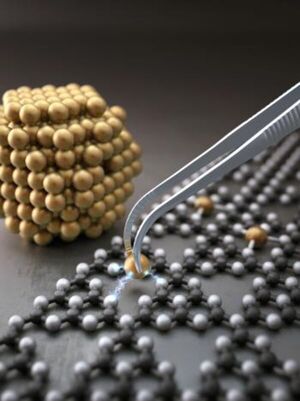
Purifying water with just a few atoms
"Due to their considerable efficiency, catalysts made of just a few atoms show great promise in the field of water treatment. In a new study, researchers looked into how to optimize the performance of these catalysts and make them viable for practical use. The results of the study, led by Prof. Jaehong Kim, are published in the Proceedings of the National Academy of Sciences. In the last few decades, nanoscale catalysts have drawn much attention in the field of water treatment. Materials at the nanoscale have numerous unique and beneficial properties to offer. More recently, researchers have been exploring the possibilities of single-atom catalysts." [...]
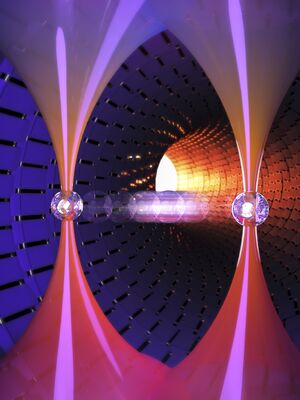
In the world’s smallest ball game, scientists throw and catch single atoms using light
"Free-flying atoms could enable a new type of quantum computer and the study of single-atom collisions In many baseball-obsessed countries like Korea, Japan and the United States, with spring months comes the start of the season and quite a few balls flying through the air. But it’s not just balls that can be thrown. On the tiniest field imaginable, scientists have now shown they can also throw and catch individual atoms using light. This amazing feat was achieved with optical traps, which use a highly focused laser beam to hold and move tiny objects. Although optical traps have been used to move individual atoms before, this is the first time an atom has been released from a trap — or thrown — and then caught by another trap. “The freely flying atoms move from one place to the other without being held by or interacting with the optical trap,” said research team member Jaewook Ahn from the Korea Advanced Institute of Science and Technology." [...]
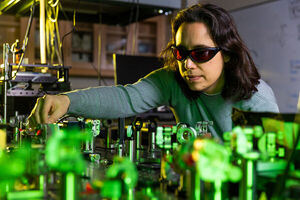
Gabriela Schlau-Cohen: Illuminating photosynthesis
"Using ultrafast spectroscopy, the chemistry professor studies the energy transfer that occurs at femtosecond timescales inside plant leaves. During photosynthesis, chlorophyll in plants absorbs packets of energy called photons from the sun’s rays. This energy is then transferred to a series of other chlorophyll molecules organized by protein scaffolds, funneling the energy into the next stage of photosynthesis. Those early light-harvesting stages of photosynthesis involve repeated excitation of pigments, as photons are passed between them. To capture these highly dynamic processes, MIT Associate Professor Gabriela Schlau-Cohen employs ultrafast spectroscopy, a technique that uses extremely short laser pulses to study events that happen on timescales of femtoseconds to nanoseconds. With this approach, Schlau-Cohen has made discoveries that reveal how photosynthesis is regulated under different light conditions, as well as how plants protect themselves from damage by dissipating excess sunlight." [...]
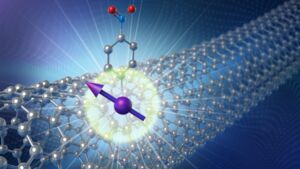
An innovative twist on quantum bits: Tubular nanomaterial of carbon makes ideal home for spinning quantum bits
"Scientists find that a tubular nanomaterial of carbon makes for ideal host to keep quantum bits spinning in place for use in quantum information technologies. Scientists are vigorously competing to transform the counterintuitive discoveries about the quantum realm from a century past into technologies of the future. The building block in these technologies is the quantum bit, or qubit. Several different kinds are under development, including ones that use defects within the symmetrical structures of diamond and silicon. They may one day transform computing, accelerate drug discovery, generate unhackable networks and more. Working with researchers from several universities, scientists at the U.S. Department of Energy's (DOE) Argonne National Laboratory have discovered a method for introducing spinning electrons as qubits in a host nanomaterial." [...]
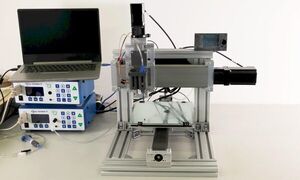
A 4D printer for smart materials with magneto-and electro-mechanical properties has been developed
"Researchers at Universidad Carlos III de Madrid (UC3M) have created software and hardware for a 4D printer with applications in the biomedical field. In addition to 3D printing, this machine allows for controlling extra functions: programming the material's response so that shape-changing occurs under external magnetic field, or changes in its electric properties develops under mechanical deformation. This opens the door to the design of soft robots or smart sensors and substrates that transmit signals to different cellular systems, among other applications. This research line focuses on the development of soft multifunctional structures, which consist of materials with mechanical properties that mimic biological tissues such as the brain or skin. In addition, they are capable of changing their shape or properties when actuated via external stimuli, such as magnetic fields or electric currents. Until now, this team of researchers had made several advances in the design and manufacturing of these structures, but they were very limited in terms of shape-design and programming of intelligent responses." [...]
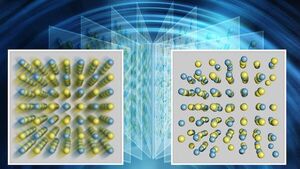
New “Camera” with Shutter Speed of 1 Trillionth of a Second Sees through Dynamic Disorder of Atoms
"Speeding up a camera shutter a million million times enables researchers to understand how materials move heat around and is a major step in advancing sustainable energy applications. Researchers are coming to understand that the best performing materials in sustainable energy applications, such as converting sunlight or waste heat to electricity, often use collective fluctuations of clusters of atoms within a much larger structure. This process is often referred to as "dynamic disorder." Dynamic disorder Understanding dynamic disorder in materials could lead to more energy-efficient thermoelectric devices, such as solid-state refrigerators and heat pumps, and also to better recovery of useful energy from waste heat, such as car exhausts and power station exhausts, by converting it directly to electricity. A thermoelectric device was able to take heat from radioactive plutonium and convert it to electricity to power the Mars Rover when there was not enough sunlight. When materials function inside an operating device, they can behave as if they are alive and dancing--parts of the material respond and change in amazing and unexpected ways." [...]
HRL Laboratories Silicon Encoded Spin Qubits Achieve Universality
"HRL Laboratories, LLC, has published the first demonstration of universal control of encoded spin qubits. This newly emerging approach to quantum computation uses a novel silicon-based qubit device architecture, fabricated in HRL’s Malibu cleanroom, to trap single electrons in quantum dots. Spins of three such single electrons host energy-degenerate qubit states, which are controlled by nearest-neighbor contact interactions that partially swap spin states with those of their neighbors. Posted online ahead of publication in the journal Nature, the HRL experiment demonstrated universal control of their encoded qubits, which means the qubits can be used successfully for any kind of quantum computational algorithm implementation. The encoded silicon/silicon germanium quantum dot qubits use three electron spins and a control scheme whereby voltages applied to metal gates partially swap the directions of those electron-spins without ever aligning them in any particular direction. The demonstration involved applying thousands of these precisely calibrated voltage pulses in strict relation to one another over the course of a few millionths of a second." [...]

Flat, pancake-sized metalens images lunar surface in an engineering first
"Penn State-led research team creates the first ultrathin, compact metalens telescope capable of imaging far-away objects. Astronomers and amateurs alike know the bigger the telescope, the more powerful the imaging capability. To keep the power but streamline one of the bulkier components, a Penn State-led research team created the first ultrathin, compact metalens telescope capable of imaging far-away objects, including the moon. Metalenses comprise tiny, antenna-like surface patterns that can focus light to magnify distant objects in the same way as traditional curved glass lenses, but they have the advantage of being flat. Though small, millimeters-wide metalenses have been developed in the past, the researchers scaled the size of the lens to eight centimeters in diameter, or about four inches wide, making it possible to use in large optical systems, such as telescopes. They published their approach in Nano Letters." [...]
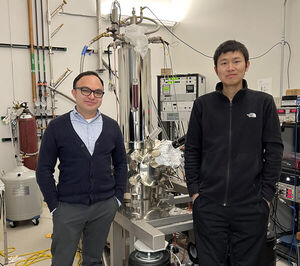
Graphene quantum dots show promise as novel magnetic field sensors
"Physicists found that speeding electrons trapped in circular loops in graphene quantum dots are highly sensitive to external magnetic fields. Trapped electrons traveling in circular loops at extreme speeds inside graphene quantum dots are highly sensitive to external magnetic fields and could be used as novel magnetic field sensors with unique capabilities, according to a new study. Electrons in graphene (an atomically thin form of carbon) behave as if they were massless, like photons, which are massless particles of light. Although graphene electrons do not move at the speed of light, they exhibit the same energy-momentum relationship as photons and can be described as “ultra-relativistic.” When these electrons are confined in a quantum dot, they travel at high velocity in circular loops around the edge of the dot. “These current loops create magnetic moments that are very sensitive to external magnetic fields,” explained Jairo Velasco Jr., associate professor of physics at UC Santa Cruz. “The sensitivity of these current loops stems from the fact that graphene electrons are ultra-relativistic and travel at high velocity.” Velasco is a corresponding author of a paper on the new findings, published March 6 in Nature Nanotechnology." [...]
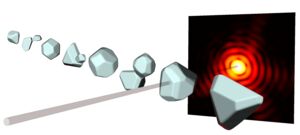
3D-snapshots of nanoparticles
"ETH researchers have managed to take three-dimensional pictures of single nanoparticles using extremely short and strong X-ray pulses. In the future this technique could even be used to make 3D-movies of dynamical processes at the nanoscale. X-ray diffraction has been used for more than a hundred years to understand the structure of crystals or proteins – for instance, in 1952 the well-known double helix structure of the DNA that carries genetic information was discovered in this way. In this technique, the object under investigation is bombarded with short-wavelength X-ray beams. The diffracted beams then interfere and thus create characteristic diffraction patterns from which one can gain information about the shape of the object. For several years now it has been possible to study even single nanoparticles in this way, using very short and extremely intense X-ray pulses." [...]
Projetos Maker
Diversos Projetos interessantes.
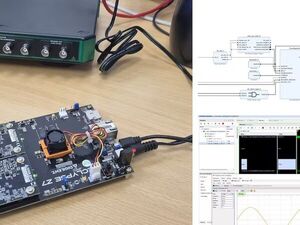
Introduction to Digital Filters using FPGA
"How to sample with High Speed ADC and DAC in FPGA and perform signal processing on the received signal. Introduction Programmable logic is great for signal processing thanks to its parallel nature. This means we can implement different processing stages at the same time from reception to filters and FFT. In this project we are going to take a look at how we can use the Digilent Eclypse Z7 board along with the Zmod AWG and Zmod digitiser to implement a signal processing chain. Unlike when we have done this in projects in the last we we will be focusing entirely on the PL and explaining the design decisions which go into the filter design also. My object is not just to show how the to create this project but for you to understand why it works also." [...]

Look at Me Light Switch
"Look at this little character (if you are within six feet) and his red light "topper" will come on. Continue to stare for three seconds and the eyeball will spin around to face you. Continue to stare for three more seconds and the controlled lights will change state (on if currently off--off if currently on). For the next five seconds, you will be ignored. Repeat if desired. The "Person Sensor" (tiny camera and microcontroller--less than ten dollars) lets an Arduino know that someone is out there (and where they are within the field of view)." [...]
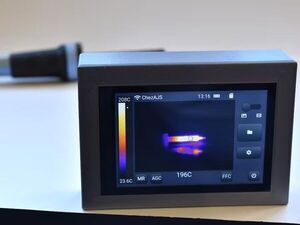
tCam: Thermal imaging camera
"tCam is an easy-to-assemble, full-feature thermal imagine camera with touchscreen and Wifi for use with desktop computers and mobile phones. Story tCam has the following features - Flir Lepton 3.5 radiometric thermal imaging sensor - 480x320 pixel capacitive touch display - Local Micro-SD card storage for images and videos - Wifi interface for remote access and control - LiPo battery for portable operation - Fully open-source It's supported by a desktop application that runs on Linux, Mac OS X and Windows, Android and iOS apps and a python driver for custom applications. Like many projects we makers embark upon, tCam came about for many reasons. I always wanted my own thermal imaging camera simply because they are very cool. I wanted to monitor circuit boards I designed as they heated up remotely from my desktop computer. I thought it might be useful for others if the camera makes the raw radiometric data easily available for non-traditional applications such as analysis using machine learning systems." [...]
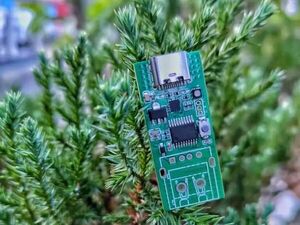
DIY Power Delivery Trigger
"let's build a PD trigger USB has evolved from a data interface capable of supplying limited power to a primary provider of power with a data interface. Today many devices charge or get their power from USB ports contained in laptops, workstations, docking stations, displays, cars, aeroplanes or even wall sockets. USB has become a ubiquitous power socket for many small devices such as cell phones, tablets, portable speakers, and other hand-held devices. Users need aUSB to fulfil their requirements not only in terms of data but also to provide power to, or charge, their devices simply, often without the need to load a driver, in order to carry out “traditional” USB functions. The USB Power Delivery (USB PD) Specification enables the maximum functionality of USB by providing more flexible power delivery along with data over a single cable. Its aim is to operate with and build on the existing USB ecosystem." [...]
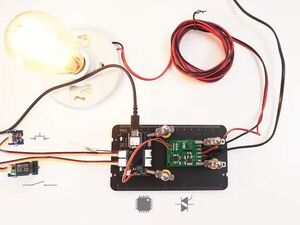
WiFi Smart Switch that finally worth it
"Before energy meters, one of my first hobbies was creating smart switches to automate my room. Before energy meters, one of my first hobbies was creating smart switches to automate my room, it all started with a switch activated with an infrared remote control, then controlled from a web page in pure HTML, Ubidots, Home Assistant, and more. However, I always wanted to be able to create one with the same experience of using those commercial switches, where you buy, and install, a mobile app for both Android and iOS, Google Home and Alexa and all without configuring servers, third-party services, or anything like that. The day has come, and the tool that has allowed me to bring this to reality is the platform developed by Espressif (from the creators of ESP32 and ESP8266), called RainMaker, this is a complete environment designed to create smart devices for our home., from curtains, switches, lamps, fans, thermostats, and much more, and to be able to market them. " [...]
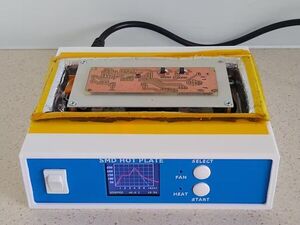
SMD Reflow Hot Plate (new version)
"A upgrade to my SMD Hot Plate with a larger hot plate, better cooling and updated software. About 6 months ago, I built a SMD hot plate using a standard 200W element (See SMD Reflow Hot Plate). Although I use it wherever possible, its small hot plate limits the size of PCB that can be used. This new version uses a 400W hot plate and doubles the size of the heating area. It also helps in overcoming the shortfalls of my previous version mainly in the area of cooling. The fan and position of that fan in the 200W version had little effect in cooling down the hot plate." [...]
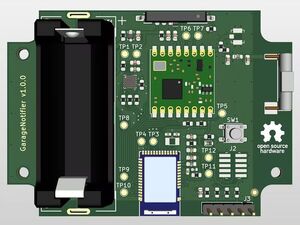
nRF52832 Helium Network Garage Notifier
"Get open/closed status of your garage (or any other) door, over Helium Network. I wanted to design a low power device that could send open/closed status of my garage door. Initially just so I can check that I didn't forget to close the garage, but later this data could also be used for an alarm feature. Since the garage is multiple floors below my apartment, Bluetooth was not an option. Also, I wanted to avoid handling the receiver side myself, but rather use an existing network which can support as many devices as I want in the future. This is where the Helium Network comes in." [...]
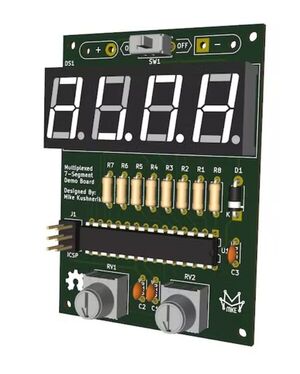
Multiplexed 7 Segment Demo
"Have you ever found 7-segment display multiplexing a little confusing? I created this project as a simple educational tool for explaining how multiplexed displays are driven and also as a super simple reference design for users who wish to integrate such a display into their project. The device is comprised of an ATMEGA328P AVR microcontroller, common cathode, 4 digit, 7 segment display, and two potentiometers that are used to adjust the digital value shown on the display and the delay used in between driving each display digit. Everything is powered via two AA batteries enclosed in a plastic holder taped to the back of the board. To prop the PCB up at a nice angle for viewing, I also designed some 3D printable legs in FreeCAD. Software Instead of the obvious choice of using Arduino for this project, I decided to try out Microchip/Atmel Studio and the Atmel ICE programmer." [...]

MyVFD - A 9-Digit VFD Info Station
"ESP32 controlled VFD screen. This device supports date/time, weather, random number generator, etc. Last year, I got an old Sharp EL-8109 calculator. Which uses a 9-digit Futaba 9-ST-08A VFD display. The calculator still works, but the shell is in bad shape, making it worth almost nothing. So I decided to use the screen inside to make something useful and look good." [...]
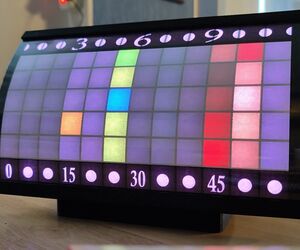
Bending Time: a Guide to Building a 3D Printed Curved LED Clock With WS2812 LEDs and ESP8266
"Time is a fundamental aspect of our lives, and there are countless ways to keep track of it - from wristwatches to wall clocks to smartphones. However, for those who want a more personalized and visually stunning way to keep track of time, I propose the construction of a DIY LED clock, a construction that can be an exciting and rewarding project. In this guide I will try to show you how to create a unique and eye-catching curved LED clock using WS2812 LEDs, which are capable of producing a wide range of vibrant colors and patterns. The clock displays the time on a 12x5 WS2812 LED matrix, with hours, minutes, and seconds represented as colored LED bars and pixels. This allows for a high degree of customization and creativity in designing the clock's display. Whether you're an experienced do-it-yourselfer or a newcomer to the world of electronics, this guide will take you step-by-step through the process of building a custom LED clock that will not only tell time but also add a touch of visual flair to any room in your home or office." [...]
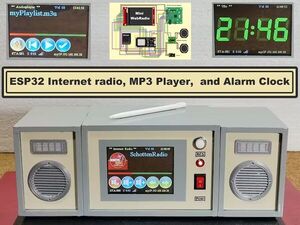
ESP32 Internet Radio, MP3 Player, and Alarm Clock
"Internet Radio, which in terms of characteristics, stability, and functions is better than commercial devices of this type. Story Internet radio (also web radio, net radio, streaming radio, e-radio, IP radio, online radio) is a digital audio service transmitted via the Internet. It can either be used as a stand-alone device running through the Internet, or as a software running through a PC. This time I will show you how to make a stand-alone Internet Radio, which in terms of characteristics, stability, and functions is comparable and even better than commercial devices of this type, and yet the price for making it is many times lower. The device contains a large color TFT display with a Touchscreen through which all controls are performed, so there is no need for additional buttons. It also has a large-digit clock with advanced alarm settings, as well as an MP3 player that can play standalone tracks and playlists." [...]
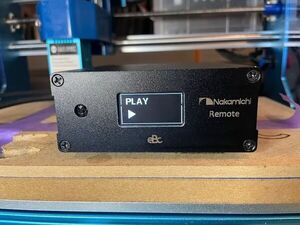
Nakamichi cassette deck remote control receiver
"A remote control receiver unit for Nakamichi cassette decks, programmable with any type of IR remote, powered by a Wemos D1 mini. A programmable infrared remote control receiver unit for Nakamichi cassette decks (RM-5 replacement). It supports the basic functions: play, stop, pause, fast forward, rewind, record and reverse. Built into a metal project box with CNC routed holes and laser engraved text. Based on an ESP8266 microcontroller (Wemos D1 mini). It connects to the deck with an 8 pin DIN plug." [...]
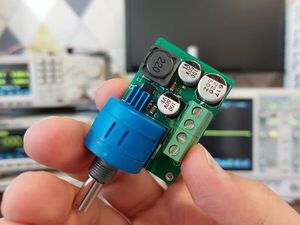
5A-35V Adjustable Switching Power Supply
"5A-35V Adjustable Switching Power Supply Story A DC-to-DC converter is one of the most commonly used circuits in electronics, especially in power supply applications. There are three major types of DC-to-DC converters (non-isolated): Buck, Boost, and Buck-Boost. Sometimes a buck converter is also called a step-down converter and a boost converter is also called a step-up converter. In this article/video, I introduce an adjustable 5A DC-to-DC converter circuit that uses an advanced chip, made by Texas Instruments, which is TPS5450. It’s a high-frequency and efficient buck converter chip that provides tight voltage regulation. I have followed several PCB design rules to ensure low noise, low EMI, and high stability of the output voltage." [...]
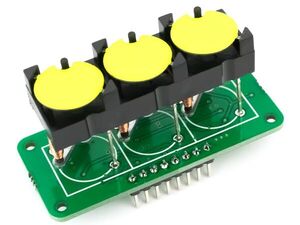
Flip-disc 1x3 Display - How to Control via Arduino
"The project describes how to build a 1x3 flip-disc display and how to control it via Arduino. Story The design of the 1x3 flip-disc display is based on the project describing a single module (1 disc). The principle of control is the same with the difference that in order to minimize the number of Arduino control lines, a 595D shift register was used. Flip-disc displays require a specific power supply, in order to flip the disc we need to supply the disc with a current pulse of about 0.5A with a precise length of about 1ms (see flip-disc datasheet) and with correct polarity. The basics of controlling flip-disc displays and the principle of operation are described on the Flipo.io website dedicated to flip-disc displays and here. " [...]
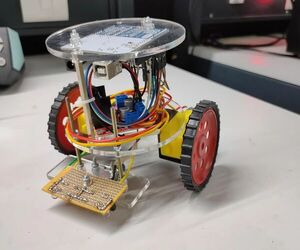
Line Following Bot
"This is a bot that follows black line. My goal was to make it as compact as possible and to use Infrared LED's instead of Infrared modules. I have used BO motors, Arduino UNO, L298N driver and IR transmitter and Receiver for the electronic components, for the chassis I used acrylic sheet which I fabricated using Laser cutting machine and for the motor clamps I 3D printed them. Supplies - Arduino UNO - BO Motor - L298N Motor driver - Infrared Transmitter and Receiver LED - Resistors: 220ohms and 4.7Kohms - Male to Male and Male to Female Jumper wire - Ball caster wheel - M3 Bolts, Nuts and female to female hex standoff spacer" [...]
Secção Videos
Videos interessantes.
That's all Folks!



